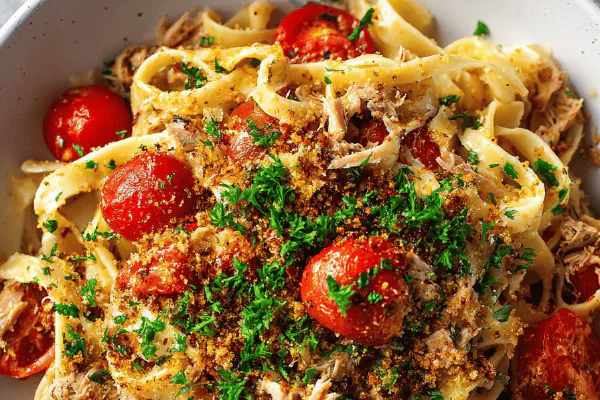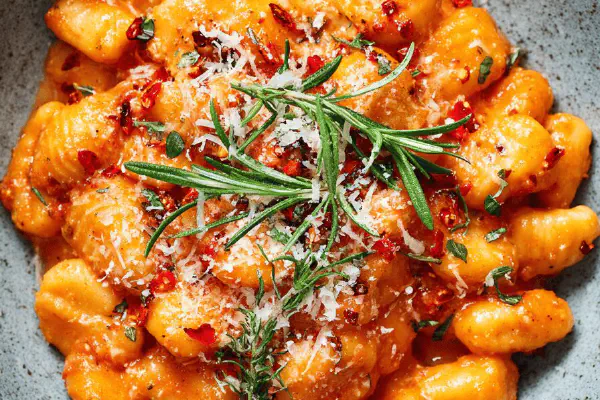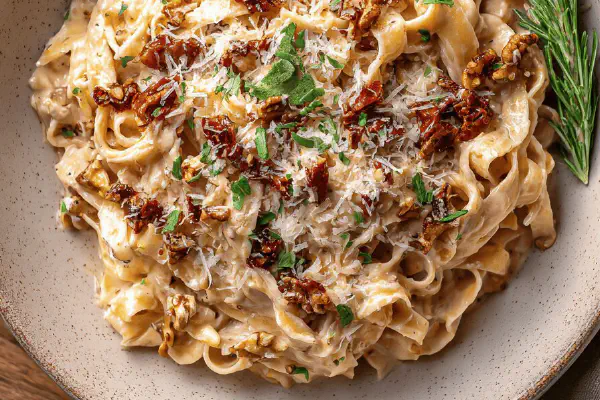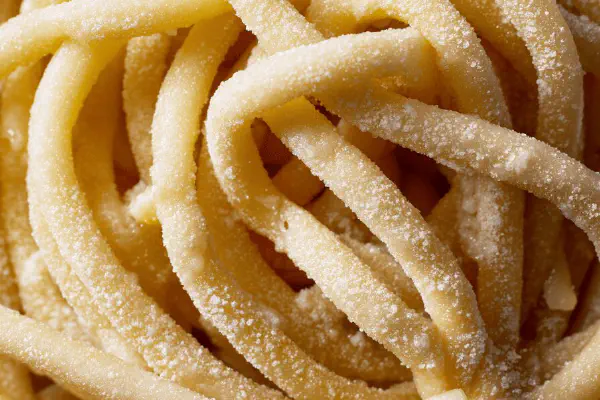Featured Recipe
Cherry Tomato Pasta Gremolata
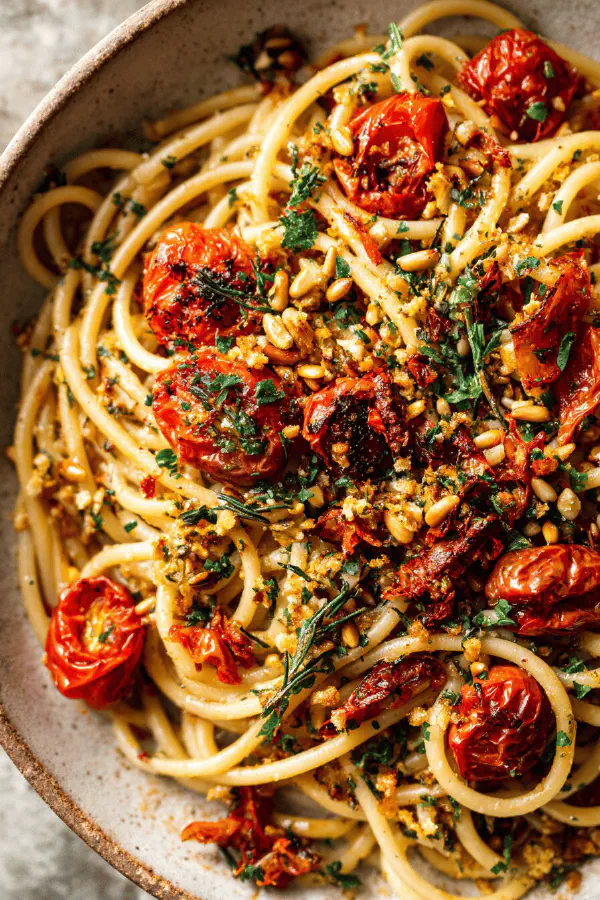
By Kate
"
Slow-roast cherry tomatoes in olive oil with garlic, thyme, and a pinch of chili flakes until caramelized and bursting. Toss with pasta cooked al dente, adding a gremolata of lemon zest, parsley, and toasted sunflower seeds instead of traditional pine nuts. Swap standard spaghetti for bucatini for a chewier bite. A drizzle of browned butter adds a nutty depth. Timing hinges on soft-skin tomatoes collapsing, pastas offering toothy resistance, gremolata fresh with zing. Involve textures — juicy bursts against herbaceous crunch. Flexible substitutions for herbs, nuts, pasta shapes. Advice for rescuing excess sauce or overcooked noodles.
"
Prep:
45 min
Cook:
20 min
Total:
Serves:
4 servings
pasta
Italian
vegetarian
roasted tomatoes
quick meals
Introduction
Cherry tomatoes left to sweat slowly in olive oil until their skins break and sweet juices thicken. That subtle slow-roasting draws out sugars, concentrating flavor without harsh char. Garlic slices add a mellow pungency finishing lightly toasted but never burnt. Thyme releases herbaceous notes into the mix. Pasta cooked to a subtle chew, never floppy. Gremolata usually pine nuts chopped bright with parsley and lemon but here sunflower seeds toast up nutty and textural, cheaper, easy, allergen-friendly. The browned butter finishes with a savory, deep layer — smells that nudge you in the kitchen — an aroma that tells when the base is ready. Timing is more about what you see and smell than stopwatch. Practical tips on saving the sauce if it dries, rescuing pasta if overcooked, avoiding common slip-ups. This is about confident hands working with simple ingredients and subtle shifts, not fuss and frills.
Ingredients
About the ingredients
Cherry tomatoes slow-roasted at low heat bring out sweetness and soften without shriveling completely. Avoid high heat which chars or shrinks fruit too fast. Olive oil must be good quality; it’s the flavor vehicle here. Garlic sliced thin releases its aroma gently compared to minced. Thyme adds subtle earthiness but feel free to swap with rosemary or oregano depending on pantry. Chili flakes are optional but give a touch of heat — less if sensitive. Bucatini chosen for its hollow center holding sauce inside but spaghetti or linguine can substitute; cooking times vary slightly. Sunflower seeds toasted till golden replace traditional pine nuts — less pricey, nut-free, adding crunch. Butter browned carefully adds nuttiness and depth but omit or substitute with olive oil for dairy-free. Lemon zest for brightness must come fresh, not dried. Fine chopping gremolata ingredients maximizes fragrance. Pecorino adds salty tang but vegan hard cheese alternatives work well too.
Method
Technique Tips
Slow-roasting tomatoes calls for patience and attention to color and texture changes rather than strict timing. Watch skin collapse and juice thicken; those tell when caramelization is right. Garlic should toast without burning — slices help monitor. Pasta cooking to al dente means testing bites frequently as cooking times vary by brand; dump promptly in colander and reserve water to control final sauce texture; starch helps bind. Browning butter needs constant watch so it doesn’t burn, transforming flavor in minutes — nutty scent, amber color. Mixing roasted tomato juices with butter coats the strands with glossy sauce; breaking tomatoes slightly releases more juice but too much mush loses pleasant texture. Adding gremolata last keeps its freshness — chopping parsley and zest finely releases oils and fragrance instantly. If sauce feels tight or dry, add pasta water in small increments to loosen without diluting flavor. Final seasoning adjusts salt and acidity, balancing richness and sharp notes. Serving hot preserves texture contrast; leftovers require only reheating carefully with splash of water to avoid drying.
Chef's Notes
- 💡 Roasting low and slow is vital. 140C works magic. Watch tomatoes get soft, skins break. Garlic slices toast just right. Aroma tells you — deep richness forms. No charred bits means success.
- 💡 Bucatini has hollow center, great for holding sauce. Other pastas work too. Just watch cooking times. Al dente means firm in center. Test frequently. If overcooked, shock in ice water. Quick fix.
- 💡 Brown butter is a flavor game-changer. Watch closely as it foams and darkens. Nutty aroma fills the kitchen but avoid burning. Adds layers to your dish. Easy but requires focus.
- 💡 Gremolata adds freshness at the end. Zest, parsley, sunflower seeds. Chop finely. At last moment keeps oils intact, bright notes elevate. Skip if too chunky, you lose that aroma.
- 💡 Runny sauce? Add reserved pasta water. Small amounts make all the difference. Too oily? A splash of vinegar or lemon juice balances richness. Always taste and adjust.
Kitchen Wisdom
How to store leftovers?
Refrigerate in airtight container. Can last a few days. Reheat gently with splash of water. Avoid drying out. Keep an eye on texture.
What if tomatoes aren’t sweet?
Try different varieties. High-quality olive oil adds depth. Heat and timing matter, adjust roasting. Explore flavor with vinegar in sauce.
Overcooked pasta?
Shock in ice water immediately. Stops cooking. Reheat carefully in the sauce with reserved water. Save texture, regain that bite, avoid mush.
Herb substitutions?
Parsley fine to swap with basil or mint if on hand. Thyme can shift to rosemary. Flexible options work well; adjust flavor profile as needed.
